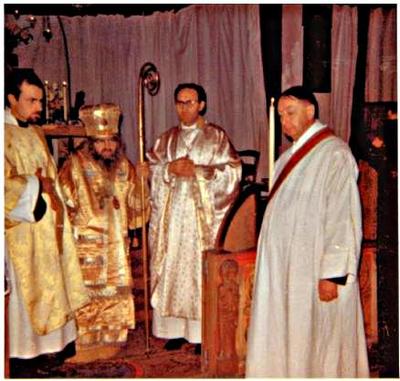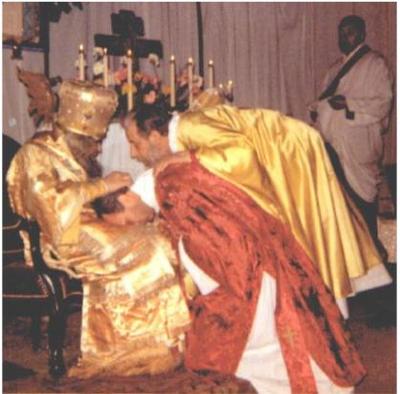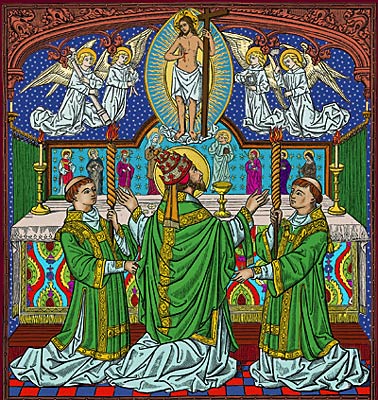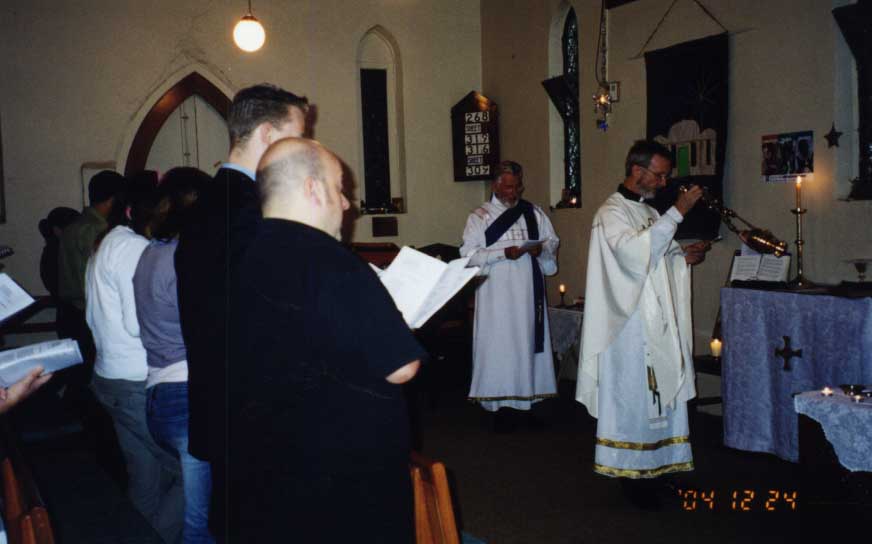A great deal has already been written, and this little article will not
attempt to be exhaustive. For detailed articles the reader can go to
Here I shall aim to give a brief account of
the
history and the present state of Orthodox worship in the western rites.The modern history of Western orthodoxy begins after 1870 with the unrealized proposals of the Revd J J Overbeck, who obtained approval from the Holy Synod of Moscow to promote an edited form of the Latin Rite in vernacular language. It seemed at the time that the Old Catholic movement could inspire an implementation of this plan. However, it was not until 1936 that a congregation was actually received in Paris under the Moscow Patriarchate. To begin with, the Overbeck Mass was used, but some theologians felt the need to search back several centuries before the schism of 1054; and by the 1970s the Eglise Catholique Orthodox de France had a mass book embracing two main types, a "rit italigue" and a "rit gallican" in which a single order branched at several points into 2 options. By this time, the Church had passed from Moscow allegiance to the Russian Church Abroad, and enjoyed the encouragement of the late Archbishop John Maximovitch. These photos came to us recently and are said to be of ordination(s) conducted by him, but when and where was not reported.


When the
first Bishop of the ECOF died, it was in some uncertainty
until the Romanian Patriarchate accepted it and provided it with its
second Bishop, Mgr. Jean de Saint-Denis. Later, however, there was a
falling-out and the present status of the French Diocese is uncertain.
Meanwhile, however, other Western Rite congregations continued, including at least one within Russia itself. We have no more information than is in this
image on a website:
Meanwhile, however, other Western Rite congregations continued, including at least one within Russia itself. We have no more information than is in this
image on a website:

Meanwhile, the
Antiochian Archdiocese in North America had received Mgr. Turner and
some others on the terms of the 1870 Moscow decision. THE WORD carried
a detailed account of this in 1962, giving a history up to the
authorization of the Antiochian Western Rite in 1958. All this is well
documented on North American webpages and we do not need to rehearse it
here in detail.
But the 1970s held further developments in store: a number of Episcopalian (Anglican) parishes, facing a proposed union with the Northern Presbyterian Church, had already approached the Archdiocese and been promised acceptance as a Western Rite. This union did not materialize, but when the innovation of female "priests" was proposed the approach was renewed by a number of parishes. At this juncture the Antiochian Archdiocese found a way to be more accomodating, by referring back to the authority of the martyred Moscow patriarch Tikhon. He had not been concerned with Western Rite proposals as such, but during his time as Russian Archbishop in North America, at the beginning of the 20th Century, he had made contacts with Anglican leaders, in the course of which he borrowed and examined their Prayer Book. The result of this was an opinion given by himself and the Moscow Patriarchate as to the modifications that would be necessary for its use by Orthodox Christians. So in the 1970s, in addition to the older Roman type of liturgy a newer Anglican type arose, in which some of the material composed by Archbishop Cranmer was used. It is important however to realize that by the time they entered Orthodoxy, these Anglican parishes had enriched their Prayer Book Eucharist with virtually all the additional material from the Latin Rite, so that although the Roman Canon was replaced by Cranmer's prayers (suitably corrected) and his Communion Devotions were used for the Order of Communion, the rites as a whole, as used today, are not very different.
It is worth remarking on the philosophy that appears to lie behind these decisions. The Antiochian Church has expended quite a lot of scholarship on examining the various aspects of the Latin and Anglican liturgical and para-liturgical practice of recent centuries up to the time that the communities were received, and on the whole found them (but not all) consistent with Orthodoxy. Thus a fair amount of material has been retained that dates from well after 1054; a number of Feasts, and a number of changes of rubric, etc., (but no feasts of RC Saints after 1054). This differs from the efforts of liturgical scholars both in Paris, and at Oxford (see below) to return the form of liturgy to that which prevailed either at the time of the schism, or even some centuries earlier, on the grounds that what is earlier is necessarily better. Antioch would appear to have acted not only out of pastoral concern (not to place unnecessary obstacles in the way) but also on the belief that, as liturgy has continued to change gradually in the East, so it has done in the West, and that many of these gradual changes are such would have happened in the West even if it had not been separated from the East.
If it is not too controversial to say so, we might add that to go searching for a golden age of Liturgy in early centuries is unnecessary if we take seriously our belief that the Holy Spirit had continued to guide the whole Church up to the time of the schism, as well as its whole remnant (the East) until our day. The goal of liturgical restoration from early centuries appealed to scholars, but the Roman and Anglican Churches have now taken it up and demonstrated its limitations.
Is it an exaggeration to say, as a friend did recently, that the rite in use amongst us is changed by barely half-a dozen words from that which S. Augustine brought to England at the end of the 6th Century? Or to say that most of the changes between the age of S. Gregory the Great and the typical edition of Trent had already occurred by the time of the schism? I am not really equipped to pronounce, and I have great respect for the efforts both of my late friend Dr Raymond Winch, and for those of the devoted and indefatigable Fr Aidan Keller. In my ignorance, however, it appears to me that both these approaches claimed to be going back to a better age, but ironically produced diametrically opposite effects in their versions: the one a radical simplification, the other a luxurious complication. It is my intention to find Dr Winch's edition of the Roman Rite according to the Ordo Romanus Primus and copy it to this site, as I think it received insufficient attention before his death; and also to provide at least a link to Fr Aidan's Sarum Rite. This may possibly assist better minds than mine to contemplate these matters further; but, I sincerely hope, without the rancour which has appeared at times amongst us.
As a way of emphasizing the essential unity of all the Orthodox rites both Eastern and Western, Antioch has taken to naming its two variants after their Saints, S. Gregory and S. Tikhon. It is easy to throw stones at that, but I prefer to work towards a time when Orthodox Western Mission will be so flourishing and the work of our scholars so thorough, that any defects in our present habits will give way to a steady enrichment and deepening of our common devotion. Just at the moment in our part of the world the "S. Tikhon" mass and the Prayer Book Offices, together with the English Hymns, seem to be meeting the need, both in our Antiochian Church and in the Russian Church in Australia. We rejoice in this, while in New Zealand with our tiny resources we have the opportunity to work on fully authenticating the Missal and the Breviary as Orthodox in new editions in digital form. At present it seems that taking them back a hundred years or so will do almost as well as a thousand, with the added advantage that detailed materials are to hand and not altogether lost to living memory. Eventually all the remaining copies of the English Missal, the Monastic Diurnal and Matins, the Prayer Book and the English Hymnal and Hymns A&M, still in use among us, will fall apart, as shall we; it is my hope that the works now in preparation will find acceptance by the next generation of Western Orthodox. (see printtexts.html)
The following photos concern our Australian scene. Fr Geoff Harvey is seen at a service last Christmas,

and the photos of a Sarum High Mass have come to me, I think, through Fr Michael Mansbridge-Wood of Tasmania. and depict, I think, not services he is actually doing, but the standard he is aiming at.
But the 1970s held further developments in store: a number of Episcopalian (Anglican) parishes, facing a proposed union with the Northern Presbyterian Church, had already approached the Archdiocese and been promised acceptance as a Western Rite. This union did not materialize, but when the innovation of female "priests" was proposed the approach was renewed by a number of parishes. At this juncture the Antiochian Archdiocese found a way to be more accomodating, by referring back to the authority of the martyred Moscow patriarch Tikhon. He had not been concerned with Western Rite proposals as such, but during his time as Russian Archbishop in North America, at the beginning of the 20th Century, he had made contacts with Anglican leaders, in the course of which he borrowed and examined their Prayer Book. The result of this was an opinion given by himself and the Moscow Patriarchate as to the modifications that would be necessary for its use by Orthodox Christians. So in the 1970s, in addition to the older Roman type of liturgy a newer Anglican type arose, in which some of the material composed by Archbishop Cranmer was used. It is important however to realize that by the time they entered Orthodoxy, these Anglican parishes had enriched their Prayer Book Eucharist with virtually all the additional material from the Latin Rite, so that although the Roman Canon was replaced by Cranmer's prayers (suitably corrected) and his Communion Devotions were used for the Order of Communion, the rites as a whole, as used today, are not very different.
It is worth remarking on the philosophy that appears to lie behind these decisions. The Antiochian Church has expended quite a lot of scholarship on examining the various aspects of the Latin and Anglican liturgical and para-liturgical practice of recent centuries up to the time that the communities were received, and on the whole found them (but not all) consistent with Orthodoxy. Thus a fair amount of material has been retained that dates from well after 1054; a number of Feasts, and a number of changes of rubric, etc., (but no feasts of RC Saints after 1054). This differs from the efforts of liturgical scholars both in Paris, and at Oxford (see below) to return the form of liturgy to that which prevailed either at the time of the schism, or even some centuries earlier, on the grounds that what is earlier is necessarily better. Antioch would appear to have acted not only out of pastoral concern (not to place unnecessary obstacles in the way) but also on the belief that, as liturgy has continued to change gradually in the East, so it has done in the West, and that many of these gradual changes are such would have happened in the West even if it had not been separated from the East.
If it is not too controversial to say so, we might add that to go searching for a golden age of Liturgy in early centuries is unnecessary if we take seriously our belief that the Holy Spirit had continued to guide the whole Church up to the time of the schism, as well as its whole remnant (the East) until our day. The goal of liturgical restoration from early centuries appealed to scholars, but the Roman and Anglican Churches have now taken it up and demonstrated its limitations.
Is it an exaggeration to say, as a friend did recently, that the rite in use amongst us is changed by barely half-a dozen words from that which S. Augustine brought to England at the end of the 6th Century? Or to say that most of the changes between the age of S. Gregory the Great and the typical edition of Trent had already occurred by the time of the schism? I am not really equipped to pronounce, and I have great respect for the efforts both of my late friend Dr Raymond Winch, and for those of the devoted and indefatigable Fr Aidan Keller. In my ignorance, however, it appears to me that both these approaches claimed to be going back to a better age, but ironically produced diametrically opposite effects in their versions: the one a radical simplification, the other a luxurious complication. It is my intention to find Dr Winch's edition of the Roman Rite according to the Ordo Romanus Primus and copy it to this site, as I think it received insufficient attention before his death; and also to provide at least a link to Fr Aidan's Sarum Rite. This may possibly assist better minds than mine to contemplate these matters further; but, I sincerely hope, without the rancour which has appeared at times amongst us.
As a way of emphasizing the essential unity of all the Orthodox rites both Eastern and Western, Antioch has taken to naming its two variants after their Saints, S. Gregory and S. Tikhon. It is easy to throw stones at that, but I prefer to work towards a time when Orthodox Western Mission will be so flourishing and the work of our scholars so thorough, that any defects in our present habits will give way to a steady enrichment and deepening of our common devotion. Just at the moment in our part of the world the "S. Tikhon" mass and the Prayer Book Offices, together with the English Hymns, seem to be meeting the need, both in our Antiochian Church and in the Russian Church in Australia. We rejoice in this, while in New Zealand with our tiny resources we have the opportunity to work on fully authenticating the Missal and the Breviary as Orthodox in new editions in digital form. At present it seems that taking them back a hundred years or so will do almost as well as a thousand, with the added advantage that detailed materials are to hand and not altogether lost to living memory. Eventually all the remaining copies of the English Missal, the Monastic Diurnal and Matins, the Prayer Book and the English Hymnal and Hymns A&M, still in use among us, will fall apart, as shall we; it is my hope that the works now in preparation will find acceptance by the next generation of Western Orthodox. (see printtexts.html)
The following photos concern our Australian scene. Fr Geoff Harvey is seen at a service last Christmas,

and the photos of a Sarum High Mass have come to me, I think, through Fr Michael Mansbridge-Wood of Tasmania. and depict, I think, not services he is actually doing, but the standard he is aiming at.






Fr Jack
6th November, 2005
6th November, 2005
The
following e-mail has arrived from our good friend Ari Adams:
"The first picture is indeed from a Divine Liturgy that Fr. Michael celebrated back in the late 90's (he's the vested priest in the photo.) The third picture is from the Alcuin Club's Sarum photo series in the early 20th c. The rest are from York and Sarum Masses done in England by the Guild of Clerks (who gave Fr. Michael permission to use photos to illustrate those parts of the mass.) You are correct in that they are meant to portray the standard (one can see photos from Michelmas before last on the Saint Petroc Journal page of Abp. HILARION's visit.) I have another photo somewhere of Fr. Michael celebrating the English rite in England a few years back as well.
<>ari"
<>
<>